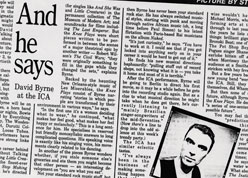ORIGINAL
PRESS CLIPPINGS

KNEE PLAYS FIRST BEND THE MIND,
Then Leaves a lot to the Imagination
Having that minimal background information in mind, however, and acknowledging Wilson's debt to the poetry and performance art of Japan, one is best advised to let the music and the movement envelop one's consciousness in their own mesmerizing fashion.
There is a story unfolded in "the Knee Plays," though it does not spring from Byrne's text, which at one point lists 51 things that will happen "in the future." Continuity comes, rather, from the design of the white cube, a structure that permeates the whole work and links each scene.
Even without a straightly followed story line, Wilson's images and Byrne's music, drawn from blues and jazz, weave their spell.
Here, just as an example, is a summary of Knee Play 9: An old man at rear stage right is bowed down by two huge bins of straw baskets that he holds on a pole pressed on his shoulders. He bends his body beneath the pole, picks it up and walks away, stopping at front stage left. The two bins of baskets gradually come to life, circling slowly at first then twirling rapidly until the baskets are in danger of flying off. Through it all, the man, pinpointed by a spotlight, remains frozen. And the scene ends.
For further understanding, you have to be there. So — be there.